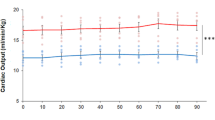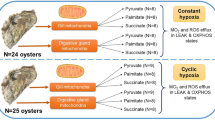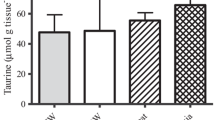Abstract
Hypoxia and warm ischemia are primary concerns in ischemic heart disease and transplant and trauma. Hypoxia impacts tissue ATP supply and can induce mitochondrial dysfunction that elevates reactive species release. The epaulette shark, Hemiscyllum ocellatum, is remarkably tolerant of severe hypoxia at temperatures up to 34°C, and therefore provides a valuable model to study warm hypoxia tolerance. Mitochondrial function was tested in saponin permeabilised ventricle fibres using high-resolution respirometry coupled with purpose-built fluorospectrometers. Ventricular mitochondrial function, stability and reactive species production of the epaulette shark was compared with that of the hypoxia-sensitive shovelnose ray, Aptychotrema rostrata. Fibres were prepared from each species acclimated to normoxic water conditions, or following a 2 h, acute hypoxic exposure at levels representing 40% of each species’ critical oxygen tension. Although mitochondrial respiratory fluxes for normoxia-acclimated animals were similar for both species, reactive species production in the epaulette shark was approximately half that of the shovelnose ray under normoxic conditions, even when normalised to tissue oxidative phosphorylation flux. The hypoxia-sensitive shovelnose ray halved oxidative phosphorylation flux and cytochrome c oxidase flux was depressed by 34% following hypoxic stress. In contrast, oxidative phosphorylation flux of the epaulette shark ventricular fibres isolated from acute hypoxia exposed the animals remained similar to those from normoxia-acclimated animals. However, uncoupling of respiration revealed depressed electron transport systems in both species following hypoxia exposure. Overall, the epaulette shark ventricular mitochondria showed greater oxidative phosphorylation stability and lower reactive species outputs with hypoxic exposure, and this may protect cardiac bioenergetic function in hypoxic tropical waters.




Similar content being viewed by others
Abbreviations
- CI:
-
Complex I
- CII:
-
Complex II
- CCO:
-
Cytochrome c oxidase
- ETS:
-
Electron Transport System
- OXP:
-
Oxidative phosphorylation system
- NO:
-
Nitric oxide
- RCR:
-
Respiratory control ratio
- RS:
-
Reactive species
- %RS/O2 :
-
The percentage of reactive species relative to oxygen consumed
References
Antunes F, Boveris A, Cadenas E (2004) On the mechanism and biology of cytochrome oxidase inhibition by nitric oxide. Proc Natl Acad Sci USA 101:16774–16779. doi:10.1073/pnas.0405368101
Barja G, Herrero A (1998) Localization at Complex I and mechanism of the higher free radical production of brain non-synaptic mitochondria in the short-lived rat than in the longevous pigeon. J Bioenerg Biomembr 30:235–243
Benard G, Faustin B, Passerieux E, Galinier A, Rocher C, Bellance N, Delage J-P, Casteilla L, Letellier T, Rossignol R (2006) Physiological diversity of mitochondrial oxidative phosphorylation. Am J Physiol 291C:1172–1182
Borutaite V, Matthias A, Harris H, Moncada S, Brown G (2001) Reversible inhibition of cellular respiration by nitric oxide in vascular inflammation. Am J Physiol 281:H2256–H2260
Chen Q, Lesnefsky EJ (2006) Depletion of cardiolipin and cytochrome c during ischemia increases hydrogen peroxide production from the electron transport chain. Free Rad Biol Med 40:976–982
Chicco AJ, Sparagna GC (2006) Role of cardiolipin alterations in mitochondrial dysfunction and disease. Am J Physiol Cell Physiol 292:C33–C44
Davidson SM, Duchen MR (2006) Effects of NO on mitochondrial function in cardiomyocytes: pathophysiological relevance. Cardiovasc Res 71:10–21
de Groot H, Rauen U (2007) Ischemia-reperfusion injury: processes in pathogenetic networks: a review. Transpl Proc 39:481–484
Glass ML, Boutilier RG, Heisler N (1983) Ventilatory control of arterial PO2 in the turtle Chrysemys picta bellii: Effects of temperature and hypoxia. J Comp Physiol B Biochemi Syst Environ Physiol 151:145–153
Gnaiger E (2003) Oxygen conformity of cellular respiration; a perspective of mitochondrial physiology. Through the lifecycle. Kluwer Academic/Plenum Publishers, New York
Gnaiger E (2009) Capacity of oxidative phosphorylation in human skeletal muscle: New perspectives of mitochondrial physiology. Int J Biochem Cell Biol 41:1837–1845
Gnaiger E (2011) Capacity of oxidative phosphorylation in human skeletal muscle. New perspectives of mitochondrial physiology. Int J Biochem Cell Biol (in press)
Gnaiger E, Lassnig B, Kuznetsov A, Rieger G, Margreiter R (1998a) Mitochondrial oxygen affinity, respiratory flux control and excess capacity of cytochrome c oxidase. J Exp Biol 201:1129–1139
Gnaiger E, Lassnig B, Kuznetsov AV, Rieger G, Raimund M (1998b) Mitochondrial oxygen affinity, respiratory flux control and excess capacity of cytochrome c oxidase. J Exp Biol 201:1129–1139
Gomez L, Li B, Mewton N, Sanchez I, Piot C, Elbaz M, Ovize M (2009) Inhibition of mitochondrial permeability transition pore opening: translation to patients. Cardiovasc Res 83:226–233
Halestrap AP, Clarke SJ, Khaliulin I (2007) The role of mitochondria in protection of the heart by preconditioning. Biochim Biophys Acta (BBA) Bioenergetics 1767:1007–1031
Hand SC, Menze MA (2008) Mitochondria in energy-limited states: mechanisms that blunt the signaling of cell death. J Exp Biol 211:1829–1840
Hickey AJR, Chai CC, Choong SY, de Freitas Costa S, Skea GL, Phillips ARJ, Cooper GJS (2009) Impaired ATP turnover and ADP supply depress cardiac mitochondrial respiration and elevate superoxide in non-failing spontaneously hypertensive rat hearts. Am J Physiol Cell Physiol 297:C766–C774
Hilton Z, Clements K, Hickey A (2010) Temperature sensitivity of cardiac mitochondria in intertidal and subtidal triplefin fishes. J Comp Physiol B Biochem Syst Environ Physiol 180:1–12
Hochachka PW, Lutz PL (2001) Mechanism, origin and evolution of anoxia tolerance in animals. Comp Biochem Physiol B 130:435–459
Kaur S, Jaggi AS, Singh N (2009) Molecular aspects of ischaemic post-conditioning. Fund Clin Pharm 23:521–536
Last PR, Stephens JD (1994) Sharks and rays of Australia. CSIRO, Australia
Lesnefsky EJ, Moghaddas S, Tandler B, Kerner J, Hoppel CL (2001) Mitochondrial dysfunction in cardiac disease: ischemia–reperfusion, aging, and heart failure. J Mol Cell Cardiol 33:1065–1089
Loiselle DS (1985) The rate of resting heat production of rat papillary muscle. Pflugers Arch 405:155–162
Muller FL, Liu Y, Abdul-Ghani MA, Lustgarten MS, Bhattacharya A, Jang Y, Van Remmen H (2008) High superoxide production in skeletal-muscle mitochondria respiring on both complex I and complex II substrates. Biochem J 409:491–499
Murphy MP (2009) How mitochondria produce reactive oxygen species. Biochem J 417:1–13
Overgaard J, Gesser H, Wang T (2007) Tribute to P. L. Lutz: cardiac performance and cardiovascular regulation during anoxia/hypoxia in freshwater turtles. J Exp Biol 210:1687–1699
Overgaard J, Stecyk JAW, Gesser H, Wang T, Farrell AP (2004) Effects of temperature and anoxia upon the performance of in situ perfused trout hearts. J Exp Biol:655–665
Papa S, De Rasmo D, Scacco S, Signorile A, Technikova-Dobrova Z, Palmisano G, Sardanelli AM, Papa F, Panelli D, Scaringi R, Santeramo A (2008) Mammalian complex I: a regulable and vulnerable pacemaker in mitochondrial respiratory function. Biochim Biophys Acta (BBA) Bioenergetics 1777:719–728
Papaharalambus CA, Griendling KK (2007) Basic mechanisms of oxidative stress and reactive oxygen species in cardiovascular injury. Trends Cardiovasc Med 17(2):48–54
Paulus WJ, Bronzwaer JGF (2004) Nitric oxide’s role in the heart: control of beating or breathing? Am J Physiol Heart Circ Physiol 287:H8–H13
Renshaw GMC, Dyson SE (1999) Increased nitric oxide synthase in the vasculature of the epaulette shark brain following hypoxia. Neurochem 10(8):1707–1712
Rolfe DF, Brown GC (1997) Cellular energy utilization and molecular origin of standard metabolic rate in mammals. Physiol Rev 77:731–758
Schneeberger S, Kuznetsov AV, Seiler R, Renz O, Meusburger H, Mark W, Brandacher G, Margreiter R, Gnaiger E (2008) Mitochondrial ischemia-reperfusion injury of the transplanted rat heart: improved protection by preservation versus cardioplegic solutions. Shock 30:365–371
Soederstroem V, Renshaw GMC, Nilsson GE (1999) Brain blood flow and blood pressure during hypoxia in the epaulette shark Hemisyllium ocellatum, a hypoxia-tolerant elasmobranch. J Exp Biol 202:829–835
Stecyk JAW, Stensløkken Kr-O, Farrell AP, Nilsson GrE (2004) Maintained cardiac pumping in anoxic crucian carp. Science 306:77
Talbot D, D’Alessandro AM (eds) (2009) Organ donation and transplantation after cardiac death. Oxford Press Inc., New York
Veksler VI, Kuznetsov AV, Sharov VG, Kapelko VI, Saks VA (1987) Mitochondrial respiratory parameters in cardiac tissue: a novel method of assessment by using saponin-skinned fibers. Biochim Biophys Acta 892:191–196
Wheaton WW, Chandel NS (2011) Hypoxia. 2. Hypoxia regulates cellular metabolism. Am J Physiol Cell Physiol 300:C385–C393
Wise G, Mulvey JM, Renshaw GMC (1998) Hypoxia tolerance in the epaulette shark (Hemiscyllium ocellatum). J Exp Biol 281:1–5
Zhong Q, Gohil VM, Ma L, Greenberg ML (2004) Absence of cardiolipin results in temperature sensitivity, respiratory defects, and mitochondrial DNA instability independent of pet56. J Biol Chem 279:32294–32300
Zoccarato F, Cavallini L, Bortolami S, Alexandre A (2007) Succinate modulation of H2O2 release at NADH:ubiquinone oxidoreductase (Complex I) in brain mitochondria. Biochem J 406:125–129
Zuurbier C, Smeele K, Eerbeek O (2009) Mitochondrial hexokinase and cardioprotection of the intact heart. J Bioenerg Biomembr 41:181–185
Acknowledgments
This research was supported by Natural Science and Engineering Research Council Discovery grants to JGR, YW, APF and CJB. CJB was supported by a Killam Faculty Research Fellowship. AJRH was supported by the University of Auckland Early Career Excellence Award. BS-R was supported by a Journal of Experimental Biology Travelling Fellowship from the Company of Biologists, a Comparative Physiology and Biochemistry Student Research Grant from the Canadian Society of Zoologists, and a Graduate Travel Award from the Department of Zoology, University of British Columbia. We thank Kevin and Kathy Townsend at the Moreton Bay Research Station for all their efforts during our stay.
Author information
Authors and Affiliations
Corresponding author
Additional information
Communicated by I.D. Hume.
Rights and permissions
About this article
Cite this article
Hickey, A.J.R., Renshaw, G.M.C., Speers-Roesch, B. et al. A radical approach to beating hypoxia: depressed free radical release from heart fibres of the hypoxia-tolerant epaulette shark (Hemiscyllum ocellatum). J Comp Physiol B 182, 91–100 (2012). https://doi.org/10.1007/s00360-011-0599-6
Received:
Revised:
Accepted:
Published:
Issue Date:
DOI: https://doi.org/10.1007/s00360-011-0599-6




